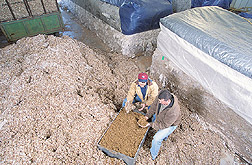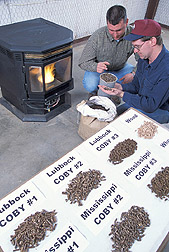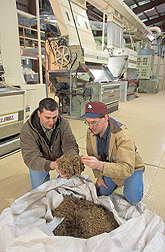Something for Cotton Country To Get Fired Up About |
|
 Agricultural engineer Greg Holt (left) and engineering aid Clint Sanders compare cotton gin byproducts before and after the COBY process. (K9847-1) |
Last winter, ARS scientists in Lubbock, Texas, warmed up beside pellet stoves burning cotton. Well, they were actually burning pellets made of cotton-gin waste in two commercial pellet stoves near their experimental cotton gin. They wanted to see whether pellets made from gin trash burn at least as well, and as cleanly, as typical pellets made from sawdust and wood chips or wheat straw. "The pellets do burn as well, but as to the cleanliness, evaluation of the data is under way," says ARS agricultural engineer Gregory A. Holt. Gin trash comprises the parts of cotton plants—stems, leaves, and burs—that are removed during ginning, which leaves the separated cotton fibers and seeds as clean as possible. Adding a little cottonseed oil to the pellets increased the heating value of the fuel to about 9,000 BTUs per pound of pellets—higher than most wood pellets. |
 Sanders (left) and Holt evaluate eight different pellet fuels for efficiency, pollutant emissions, and ease of handling. (K9846-1) |
"The pellets leave more ash than wood, but the ash is the loose form that can be easily dumped from the stove's ash collector," says Holt. Aladdin Hearth Products of Colville, Washington, lent the two stoves for the Lubbock tests. The ARS scientists have devised a new low-cost way to add value to cotton waste—a patented system known as the COBY (Cotton Byproducts) process. It uses a hot, gelatinized starch solution that acts as a glue to hold the cotton waste ingredients together and a lubricant to smooth the mixture's flow through the extrusion equipment. The procedure cooks, sterilizes, and improves nutrient availability in the mixture, which can be formed into pellets for various uses. Holt and colleagues in Lubbock's cotton country burned three types of pellets made by the COBY system using waste from ARS gins in Lubbock as well as in Stoneville, Mississippi. The pellets contained a low-starch mix, a high-starch mix, or a low-starch/low-cottonseed oil blend. "Gin waste can have a different makeup depending on the cotton-growing areas. Some have more woody material, like plant stems. We are studying how that affects their heating efficiency," Holt says. |
|
|
The pelletizing is done using a commercially available pellet mill at the researchers' facility. The pellet mill presses the cotton-gin trash and other ingredients into pellets that are about 1/4 inch wide and 1/2 to 1 inch long. According to the Pellet Fuels Institute, 57 firms reported making bagged pellet fuel, with sales of 730,000 tons during the 2000-2001 heating season, a 14-percent increase over the previous season. All the pellets are made with biomass materials—the products of commonly grown plants and trees. Pellets made for residential use can be bought at stove dealers, nurseries, building supply stores, and feed and garden supply stores nationwide. Holt wants to see whether cotton waste can make better pellets for feed and fuel If he's successful, the nation's 2.5 million tons of cotton gin waste would be more useful. He says the COBY system is very flexible, since it is easy to add and thoroughly mix extra ingredients as desired, such as cottonseed oil for fuel pellets, nitrogen for fertilizer pellets, or protein for feed pellets. "The process cooks and blends several different ingredients together, so you can easily tailor-make products," Holt says. "We can add things like molasses, cottonseed, various grain meals, and protein supplements in making feed pellets." Holt is looking for new uses for cotton waste, such as a loose, nonpelletized mulch for flower beds. Such uses could bring a higher price and a more consistent use of cotton byproducts. "By creating value-added products," Holt says, "we improve the marketability of cotton byproducts, turning them from waste into a commodity that can raise ginning income and potentially create jobs in rural areas." Cooking the starch solution and added ingredients has the added bonus of killing any weed seeds or fungi that might be in the cotton waste, making it safe as a fertilizer or mulch. Holt and colleagues—together with Illinois-based Summit Seed, Inc.—are testing the cotton-byproducts mulch on flower beds in Illinois, at a local university's test facility. The seed company is interested in working with ARS to commercialize the mulch and fertilizer pellets. Insta-Pro International, a division of Triple "F," Inc., of Des Moines, Iowa, a manufacturer and marketer of extrusion equipment and technologies, supplied the Lubbock researchers with an extruder to begin the COBY testing. USDA has granted Insta-Pro an exclusive license to either process COBY or issue a sublicense to other companies. Insta-Pro's marketing strategy is to offer cotton gins the opportunity to purchase the system to process COBY products, along with granting the gins a sublicense agreement for the manufacture and marketing of COBY products. Holt says several cotton gins are currently considering coming together to build a plant to process and sell their own waste. In February 2002, the researchers started a 62-day feeding trial of COBY feed made at a local producer's facility. The trial is being done with 100 to 120 heifers at a feedlot at Texas Tech University in Lubbock. They are testing various mixtures, including one with a commercial protein supplement added. Earlier tests showed the extruded COBY product made the feed more digestible than commonly used cottonseed hulls. Cotton Incorporated of Raleigh, North Carolina, helps fund the research and development for all the trials of the various uses for cotton waste processed with COBY.—By Don Comis, Agricultural Research Service Information Staff. This research is part of Quality and Utilization of Agricultural Products (#306), an ARS National Program described on the World Wide Web at http://www.nps.ars.usda.gov. Gregory A. Holt is with the USDA-ARS Cropping Systems Laboratory, P.O. Box 215, Lubbock, TX 79401; phone (806) 746-5353, ext. 226, fax (806) 744-4402.
|
| "Something for Cotton Country To Get Fired Up About" was published in the April 2002 issue of Agricultural Research magazine. |







